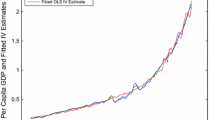Abstract
We shed some new light on the Environmental Kuznets curve (EKC) and show how it can be viewed as a particular form of equilibrium relationship, where technology and preference parameters determine the shape of the curve. In contrast to most of the literature on the EKC, we estimate a theoretically consistent model on long-run data (Swedish sulfur emission, covering the period 1900–2002). Furthermore, we test and date structural change. The model suggests four regimes, 1900–1918, 1919–1933, 1934–1967 and 1968–2002, generating four rather different patterns for pollution over time. The policy-conclusions are consonant with Pearce’s general view about the EKC: there is no theoretical presumption that it has an inverted U shape, nor should any country try to “grow out of the environmental problems” without analyzing the benefits and costs of so doing.
Similar content being viewed by others
References
Aghion P, Howitt P (1998) Endogenous growth theory. MIT Press– 14
Andreoni J and Levinson A (2001). The simple analytics of the environmental kuznets curve. J Public Econ 80(2): 269–286
Bai J, Perron P (1998) Estimating and testing linear models with multiple structural changes. Econometrica 66(1):47–78, January 1998. available at http://ideas.repec.org/a/ecm/emetrp/v66y1998i1p47-78.html
Bai J and Perron P (2003). Computation and analysis of multiple structural change models. J Appl Economet 18: 1–22
Brock W, Taylor M (2004) The green solow model. Technical Report 10557, NBER, 1050 Massachusetts Ave., Cambridge, MA 02138
Cantore N (2006) Does the environmental kuznets curve exist? evidence from climate change integrated assessment models. Paper presented at the 13th Ulvön Conference on Environmental Economics, Ulvön, Sweden, 19–21 June
Copeland B and Taylor S (2004). Trade, growth and the environment. J Econ Lit XLII: 7–71
Dijkgraaf E,Volleberg H (1998) Environmental kuznets revisited. time-series versus panel estimation: the co2 case. Research Memorandum 9806, Erasmus University. Research Centre for Economic Policy
Egh H (2005) The Environmental Kuznets curve: theory and evidence. Phd diss, Universität Zürich
Grossman G, Krueger A (1994) Economic growth and the environment. Working Paper 4634, National Bureau of Economic Research
Gustavsson-Bergquist A-K, Lindmark M (2006) Is state-firm co-operation instrumental for reducing pollution? environmental performance in the swedish and canadian metal smelting industry 1960–2005. Department of Economic History, University of Umeå, June
Halkos GE (2003). Environmental kuznets curve for sulfur: Evidence using gmm estimation and random coefficient panel data models. Environ Dev Econ 8(4): 581–601
Hartman R and Kwon O (2005). Sustainable growth and the environmental kuznets curve. J Econ Dyn Control 29(10): 1701–1736
Lekakis J (2000) Environment and development in a southern european country: which environmental kuznets curves? J Environ Plan Manage 139–156
Lopez R (1994). The environment as a factor of production: The effects of economic growth and trade liberalization. Journal of Environ Econ Manage 27(2): 163–184
Nahman A and Antrobus G (2005). The environmental kuznets curve: a literature survey. S Afri J Econ 73(1): 105–120
Pearce D (2004). Growth and the environment: can we have both?. Environ Matters 4(1): 14–15
Pearce D (2005) Managing environmental wealth for poverty reduction. http://www.iucn.org/en/ news/archive/2005/09/pearce_report_ver5_5_sep_05.pdf, United Nations Development Programme, August 31 2005
Perman R and Stern D (2003). Evidence from panel unit root and cointegration tests that the environmental kuznets curve does not exist. Aust J Agric Resour Econ 47(3): 325–347
Plassman F, Khanna N (2005) Preferences, technology and the environment: Understanding the environmental kuznets curve hypothesis. Technical Report Working Paper 0313, Department of Economics, State University of new York, Binghamton, NY 13902-6000
Ramanathan R (2002) Introductory econometrics with application, 5th edn. Harcourt College Publishers
Reis A (2001). Endogenous growth and the possibility of eliminating pollution. J Environ Econ Manage 42(3): 360–373
Schneider V and Pearce D (2004). What saved the whales from extinction? an economic analoysis of 20th century whaling. EcoNZ@Otago 1(13): 1–3
Schou P (1992). Pollution externalities in a model of endogenous fertility and growth. Int Tax Public Finance 9(6): 709–725
Shafik N, Bandyopaday S (1992) Economic growth and environmental quality: time series and cross-country evidence. Background paper for the world development report, The World Bank
Stern D (2004). The rise and fall of the environmental kuznets curve. World Dev 32(8): 1419–1439
Stokey N (1998) Are there limits to growth. Int Econ Rev 1–31
Turner K (2005) The blueprint legacy. a review of professor david pearce’s contribution to environmental economics and policy. Working Paper PA 05-01, The Centre for Social and Economic Research on the Global Environment (CSERGE), University of East Anglia, UK
World Bank (1992). World Development Report 1992. Development and the environment. World Bank, Washington, DC
Zeileis A and Kleiber C (2005). Validating multiple structural change models – a case study. J Appl Economet 20: 685–690
Author information
Authors and Affiliations
Corresponding author
Rights and permissions
About this article
Cite this article
Johansson, PO., Kriström, B. On a clear day you might see an environmental Kuznets curve. Environ Resource Econ 37, 77–90 (2007). https://doi.org/10.1007/s10640-007-9112-9
Published:
Issue Date:
DOI: https://doi.org/10.1007/s10640-007-9112-9




